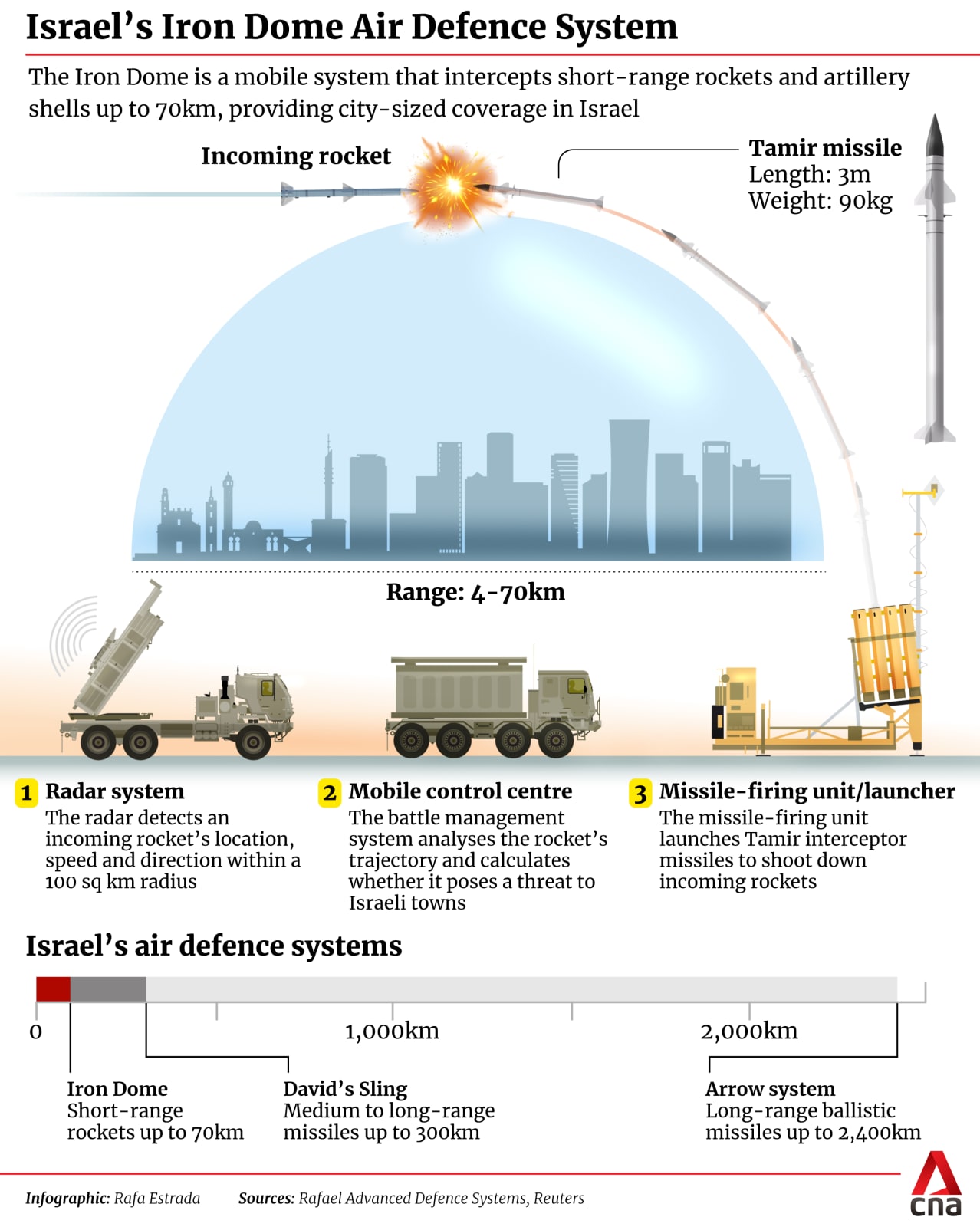CNA Explains: How Israel's air defence systems fended off Iranian missiles
The barrage on Oct 1 took place just months after Iran’s first-ever direct attack on Israel.

Israel's Iron Dome anti-missile system intercepts rockets after Iran fired a salvo of ballistic missiles, as seen from Ashkelon, Israel, Oct 1, 2024. (Photo: Reuters/Amir Cohen)

This audio is generated by an AI tool.
On Tuesday (Oct 1), Iran fired a barrage of missiles at Israel, prompting the latter to vow retaliation.
Iran's Revolutionary Guard Corps have said the assault was payback for Israel's killing of Hezbollah chief Hassan Nasrallah last week, on top of continued aggression in both Lebanon and Gaza.
This latest salvo came after Iran in April launched a swarm of explosive drones and fired missiles in its first-ever direct attack on Israel.
What are the elements of Israel's air defence system, and how did they work together?
Israel has a "layered" air and missile defence architecture built to counter a wide variety of threats.
Iron Dome
This well-known anti-missile shield makes up the lowest tier of this layered system.
It is designed to intercept short-range rockets at a distance of up to 70km.
The Iron Dome system uses radars to detect incoming threats, including rockets, missiles, mortars and drones. Once detected, it fires its own interceptor missiles to take them out, according to a report by the Australian Broadcasting Corporation News.
Since it was operationalised in 2011, it has intercepted thousands of projectiles launched by Hamas and Hezbollah, the Israeli military said.


David's Sling
Above the Iron Dome, in the middle tier, is a medium-to-long-range interceptor known as David’s Sling.
Installed in 2017, it is designed to detect and destroy ballistic and cruise missiles, as well as drones, at a reported range of up to 200km, Bloomberg reported.
With this range, it covers southern Lebanon as well as Gaza.

Arrow 2 and Arrow 3
To intercept missiles fired from up to 2,400km away and outside the Earth's atmosphere, Israel relies on its arrow missile defence system, made up of Arrow 2 and Arrow 3.
Both were said to have been used to bring down ballistic missiles fired by the Houthi rebels in Yemen last month.


Iron Beam
The Israeli military is also testing a new system called Iron Beam, which uses lasers to intercept projectiles fired at close range.
A top executive from Israel's Rafael Advanced Defense Systems told US-based digital magazine Breaking Defense in March that the company was on track to deliver the Iron Beam in 2025.
The three current systems - the Iron Dome, David's Sling and Arrow 2 and 3 interceptors - were reportedly used to foil Iran's attack in April, which involved drones and cruise missiles.
How effective were they?
According to international media reports, the defence systems intercepted 99 per cent of the more than 300 drones, ballistic and cruise missiles launched by Iran during April's attack.
On Tuesday, Israel's air defences were activated and most missiles were intercepted, said Israeli Defense Forces spokesperson Daniel Hagari.
According to BBC, the David's Sling and Arrow 2 and 3 would have played instrumental roles in dealing with Iran's attacks.
How was the US involved?
The United States' Department of Defense confirmed its forces had helped Israel shoot down the latest barrage of Iranian ballistic missiles.
Two US Navy destroyers fired about a dozen interceptors against the missiles. The Pentagon press secretary Major General Pat Ryder said the US military "coordinated closely" with its Israeli counterparts to take down the projectiles.
He, however, did not confirm whether they hit any of the Iranian missiles used in the attack - adding that this information was yet to be determined.
The US also lends its support to Israel with military assistance of at least US$3.8 billion annually.
In April, the US House passed a US$95 billion legislative package providing security assistance to Ukraine, Israel and Taiwan.
Of this, US$26 billion goes to Israel, including aid for humanitarian needs.
Israel also said last week it had secured an US$8.7 billion aid package from the US. The money would be used to support its ongoing military efforts and to maintain a qualitative military edge in the region.
Included in the package was US$3.5 billion for essential wartime procurement, which had already been received and earmarked for critical military purchases, while US$5.2 billion was designated for air defence systems.
What was the damage to Israel?
Tuesday's attack saw about 200 ballistic missiles fired towards Israel, according to United States' National Security spokesperson Jake Sullivan.
The Israel Defense Forces earlier said about 180 missiles were launched from Iran.
While it is still unclear exactly how many missiles landed in Israel, a Washington Post article noted that videos shared on social media showed direct impacts in Tel Aviv and the Nevatim Airbase in the Negev desert.
Footage verified by the BBC showed missile strikes near a shopping mall in the Israeli city.
According to the Israeli Defense Forces, central Israel was on the end of "a small number" of hits.
The Israeli military published a video of a school in the central city of Gadera that was heavily damaged by an Iranian missile.
No injuries were reported in Israel, but one man was killed in the occupied West Bank, according to authorities.
Will Iran be deterred?
Likely not, as some experts have highlighted.
Mr Ali Vaez, Iran project director and senior advisor of think-tank International Crisis Group wrote on X (formerly known as Twitter) that every indication emerging from Iran's missile attack against Israel was a "bigger and more brazen effort" than April.
"That sought, and failed, to deter future attacks against Iran or its allies, who in recent months and days have suffered major setbacks," he wrote.
He added that the killing of Hamas leader Ismail Haniyeh in Iran, death of Hezbollah chief Nasrallah and the start of Israeli operations in southern Lebanon appear to have "finally tipped" Iran's decision in favour of a "direct, over retaliation", even at the risk of counter-strikes.
Mr Hugh Lovatt, a senior policy fellow at the European Council on Foreign Relations also pointed to Israel's military action.
Mr Lovatt, who is with the think-tank's Middle East and North Africa Programme, quoted an article he had written on X, saying: "Tehran will view a widening Israeli campaign against Iranian-linked groups as an existential threat, risking a more forceful response that Iran has so far sought to avoid, and potentially pushing it towards nuclear weaponisation."
This aligns with an earlier statement by Iran's General Staff of the Armed Forces that any Israeli response would be met with "vast destruction" of Israeli infrastructure.















